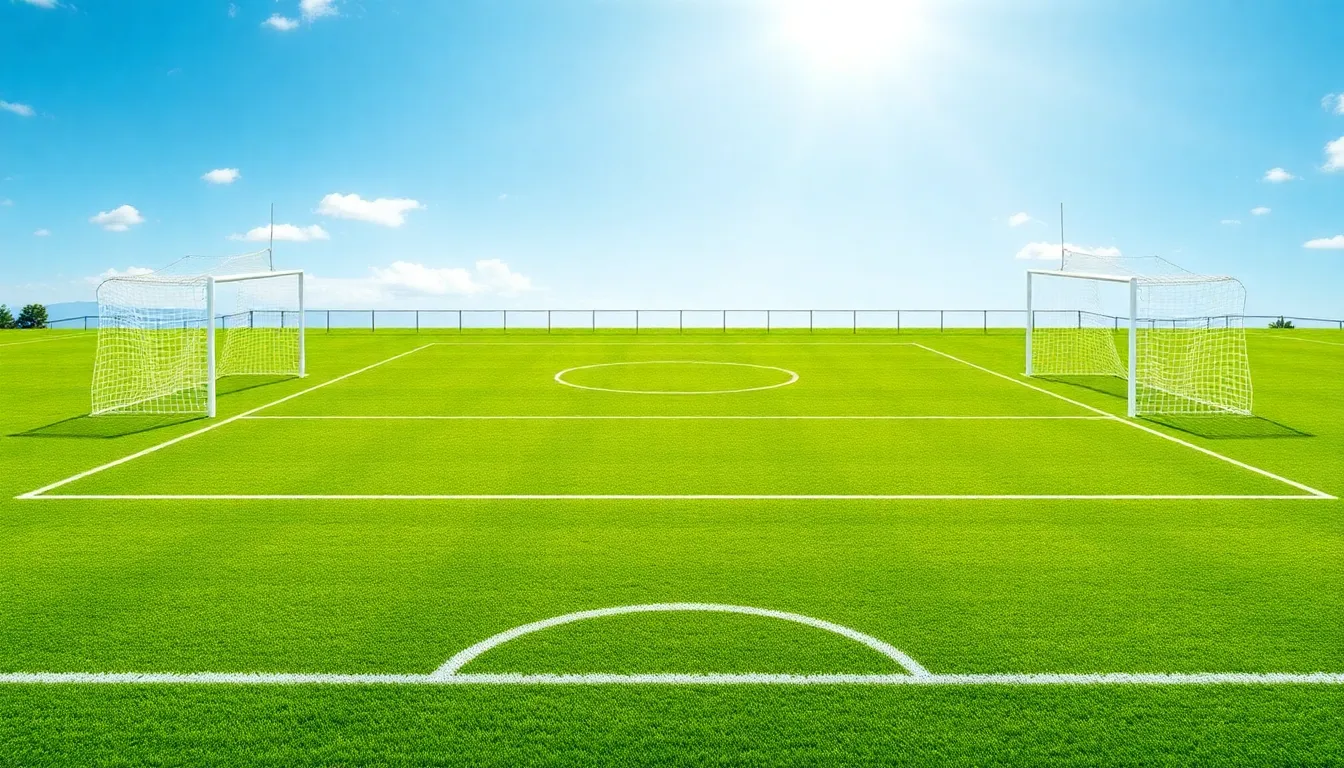When it comes to soccer, size matters—at least when it comes to the field. Imagine trying to dribble a ball on a postage stamp; it wouldn’t be pretty. A regulation soccer field is the unsung hero of the game, providing the perfect stage for dazzling footwork and nail-biting moments. It’s where legends are born and dreams are dashed, and knowing its dimensions can make anyone sound like a soccer aficionado at the next BBQ.
Regulation Soccer Field
A regulation soccer field defines the playing area for official matches. Understanding its dimensions and markings provides insight into the game.
Dimensions and Measurements
The standard dimensions for a regulation soccer field range from 100 to 110 meters in length and 64 to 75 meters in width. These measurements allow for adequate play space. FIFA guidelines note that fields used in international matches must meet these specifications. Additionally, the goals measure 7.32 meters in width and 2.44 meters in height. Accurate measurements ensure a consistent playing experience across different venues.
Field Markings
Field markings play a critical role in soccer gameplay and adherence to its rules. The center circle, with a radius of 9.15 meters, marks the point for kick-offs. Goals are marked by the penalty area, measuring 16.5 meters from the goal line. This area is vital for defining fouls and penalties. Other essential markings include the penalty spot, located 11 meters from the goal line, and corner arcs with a radius of 1 meter. Each marking serves a specific purpose, contributing to clarity in the game’s rules and flow.
Materials Used for Regulation Soccer Fields

Soccer fields utilize a variety of materials to enhance gameplay performance and maintenance. The choice between grass and turf significantly impacts the playing experience.
Grass vs. Turf
Natural grass offers a traditional feel, promoting a softer landing during falls. Grass provides better traction when moist and has a cooling effect during hot weather. Synthetic turf, on the other hand, provides durability and less susceptibility to weather damage. Turf maintains consistent playability year-round, often requiring fewer interruptions for maintenance. Each option presents specific advantages, with grass offering authentic gameplay and turf delivering convenience and resilience.
Maintenance Considerations
Regular upkeep proves vital for both grass and turf fields. Grass requires frequent mowing, watering, and fertilization to remain healthy and playable. Timely aeration also helps to prevent compaction. Turf maintenance includes brushing fibers and infill, along with regular inspections for damage. While turf needs less water and can handle heavier usage, it does require specific cleaning methods to prevent debris build-up. Ultimately, understanding these maintenance needs aids in ensuring optimal playing conditions.
Importance of Regulation Soccer Fields
Regulation soccer fields play a crucial role in ensuring the integrity of the game. Their standardized dimensions allow players to compete under consistent conditions.
Fair Play and Safety
Fair play hinges on the proper dimensions and markings of the field. Accurate goal measurements ensure equal scoring opportunities for both teams. Safety is critical; regulation fields provide adequate space for players to move and avoid collisions. Clear markings for penalty areas set defined boundaries. Such boundaries help prevent disputes during matches. Furthermore, well-maintained surfaces reduce injury risks by minimizing uneven ground and debris. Adhering to these standards ensures a level playing field where skill and strategy prevail.
Impact on Player Performance
Player performance is directly tied to the quality and size of the playing surface. Adequate field dimensions allow for varied playing styles, enhancing creativity and strategy. Players excel in space, using their skills effectively on a properly sized field. Additionally, a well-maintained field influences traction, affecting speed and agility. Natural grass can provide a grip underfoot for quick movements. Conversely, synthetic turf offers consistent surface contact, regardless of weather conditions. Field conditions significantly impact morale and energy levels, leading to improved overall performance by players.
Variations in Soccer Field Regulations
Regulations for soccer fields vary across different leagues and levels. Professional leagues, such as Major League Soccer, adhere to international standards set by FIFA. These fields typically measure 100 to 110 meters long and 64 to 75 meters wide. In contrast, youth leagues might use smaller dimensions, often ranging from 70 to 90 meters in length and 45 to 60 meters in width. This flexibility accommodates varying skill levels and player sizes. Furthermore, local clubs may implement their own specific guidelines based on available space and player safety.
Differences Across Leagues
Different leagues often impose unique regulations on soccer field dimensions and markings. For instance, the English Premier League follows FIFA’s field standards closely. On the other hand, recreational leagues may choose to adjust their sizes, promoting inclusivity and participation among diverse age groups. These adjustments can include smaller goal sizes and reduced field lengths. By tailoring dimensions, leagues enhance player development while ensuring an enjoyable experience.
Modifications for Different Ages
Ages significantly influence soccer field modifications. Younger players typically require smaller playing areas to facilitate skill development and prevent overwhelming situations. Fields for U8 players may measure around 60 by 40 meters, promoting easier ball control. As players progress in age and skill, dimensions gradually increase, aligning with their advanced capabilities. Adult leagues revert to standard field dimensions, enhancing competitive play and strategic elements. Each modification caters to age-appropriate experiences, fostering a love for the game while accommodating player growth.
Conclusion
Understanding the dimensions and maintenance of a regulation soccer field is essential for players, coaches, and fans alike. The field not only sets the stage for thrilling matches but also ensures fair play and safety. With proper upkeep and adherence to regulations, players can enjoy an optimal experience that enhances their skills and fosters a passion for the game. As soccer continues to grow globally, recognizing the significance of these standards remains vital for the sport’s integrity and enjoyment.

